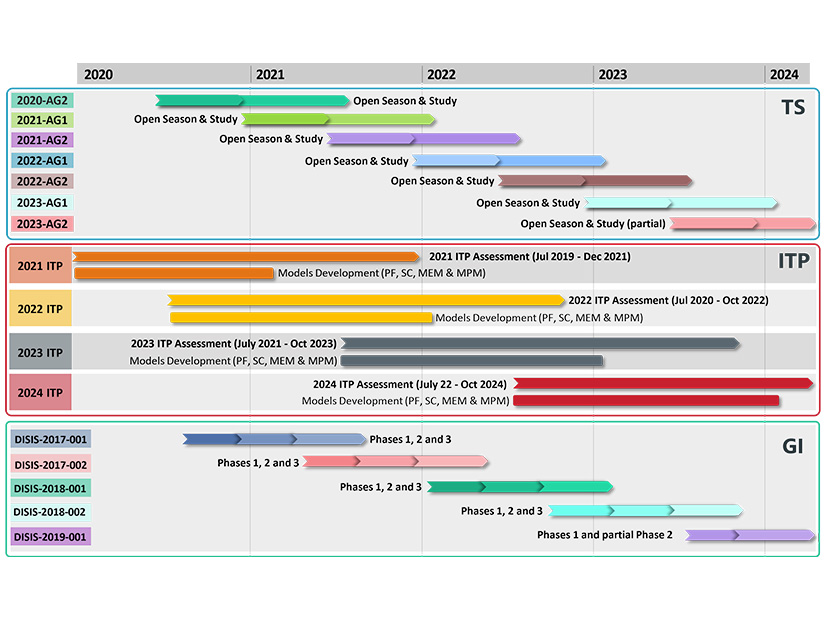SPP staff and stakeholders last week discussed high-level recommendations for consolidating the RTO’s transmission planning processes, an initiative the RTO says could save $9 million annually by 2030 while also producing a more holistic view of its transmission needs.
“I think there’s even more value to be gained from this,” predicted SPP COO Lanny Nickell, who said a business case that “fleshes that out” is being developed.
“By consolidating the processes and trying to meet all the needs with single study process — whether it’s new generation that want to be interconnected or load growth — we believe there’s a lot of value to be gained by deriving the optimal transmission set … in more equitable fashion than today,” Nickell said.
During an education session Wednesday, Nickell told the Markets and Operations Policy Committee that SPP’s current planning processes cost about $28.5 million annually, but that the new consolidated process is projected to cost $25.5 million during its first three years and $24.7 million in Year 4 and beyond. Savings are expected to reach up to $8.9 million by 2030.

Staff currently spends more than 132,000 hours annually in the planning processes, a number that is projected to drop by nearly 14,000 hours with consolidation. Nickell said it will take two to three years and $7.5 million to implement the consolidated approach.
The Strategic Planning Committee last year created the Strategic and Creative Re-engineering of Integrated Planning Team (SCRIPT) to analyze the RTO’s interconnected planning processes and applicable cost-allocation methods. (See “SPC Takes Look at Tx Planning,” SPP Briefs: Week of Aug. 31, 2020.)
The SCRIPT created six sub-teams, comprised of its members and SPP staff, to focus on consolidation, services, optimization, decision quality, transfers and cost-sharing. They have produced 48 recommendations and sub-recommendations over more than 60 meetings and 11 months. The SCRIPT has provided feedback on the recommendations, which are under review and likely to change.
Nickell said the team is nearing the end of its policy development and plans to share its results and a final version of its draft report during the October governance meetings.
“We do have some work ahead of us,” he said. “There’s going be another group of recommendations that will enable more benefits from having a consolidated process.”
The sub-team working toward an “appropriate consolidation” of SPP’s Integrated Transmission Planning (ITP), generator-interconnection and transmission service studies, is central to SCRIPT’s success. It recommended:
- creating a common base model set to meet regional planning needs required by SPP’s Tariff and NERC reliability standards;
- modifying the high-priority study planning assessment requirements to provide additional scope flexibility and allowing it to be performed on an as-needed basis;
- expanding the model data systems used for collection and review, and developing automation and an intermediary database with links to existing regional planning tools to better correlate input data, processes and study outcomes; and
- staff and stakeholders work together to evaluate, approve and build out design- and implementation-level processes for one of the two consolidated options for customer optionality, cost-certainty of assigned upgrades, and regulatory planning compliance.
The team’s two-phase approach involves first consolidating ITP, GI, transmission service, NERC transmission planning, and local planned transmission system changes processes. That would be followed by combining system load, sponsored upgrades, and generator retirement processes.
“We are going to be bound by NERC requirements to some degree. We’re going to have to keep some studies on track,” SPP’s Kelsey Allen said.
Allen said staff is considering providing “fast-track” options to quickly connect resources. “We’re hoping to be able to create a lot more efficiency in the processes than we have today, and that comes from the first consolidation,” he said.
Antoine Lucas, SPP’s engineering vice president, said his optimization sub-team recommendation that SPP develop a process to conduct holistic planning needs and solutions assessments complements the consolidation recommendations.
“It gives guidance on the approach and how to do that,” he said. “This really is all about identifying the projects that provide the most value to the overall region, but that also bolster the reliability expectation we have.”
Under the recommendation, staff would assess proposals for addressing market efficiency, public policy needs, and reliability issues for network load service and GI requests. Once the portfolio is established, staff could then conduct an impact analysis of GI requests and applicable transmission service requests impacts and use the results as a component of cost-sharing considerations.
“The fact [is we] don’t know what’s going to come out of the planning process. We do believe we can increase the value of transmission portfolios that are being recommended and approved,” Nickell said.
The Generator Outage Task Force (GOTF) also briefed MOPC during the education session on its work to address outage-scheduling practices and concerns over how to reliably schedule outages given the changing resource mix.
The task force was created after SPP declared a Level 1 energy emergency alert and it called for conservative operations 10 times in 2019. The grid operator attributed six of the 10 operations events to generation outages.
The group is recommending a generation assessment process that includes a long-term horizon (five years) and a short-term view (the next seven days). The assessment’s wind, demand, capacity and outage, and forced unscheduled outages will serve as inputs to determine the number of maintenance outages that can be taken without threatening reliability.
The GOTF is also urging SPP to change the outage/derate reporting threshold from 25 MW to 10 MW and to allow forced outages to have up to seven days of maximum lead time, so that they align with NERC’s generating availability data system.
The recommendations will be finalized during the task force’s next meeting Sept. 24.



